If you could ride along with us on bike after bike, year after year, you might catch us occasionally bemoaning how bike manufacturers don’t always take our sage advice on what seem like obvious updates or improvements to a model.
We’re confident that if we think something needs to be changed, removed or added, the consumer will come out the winner. Often, consumers agree with critiques from motomags, so when a bike continues in the line-up unchanged time and again, we wonder what an OEM is thinking.
Kawasaki has openly embraced input from riders and owners when it comes to the 2010 Concours 14.
According to Kawasaki’s Karl Edmondson, the ‘10 Connie might be one of the most consumer-influenced models in Kawi history. Of the new rider environment and touring amenity updates on the C-14, virtually all are a combined result of owner/rider feedback, and the American arm of Kawasaki pushing the mothership in Japan (Kawasaki Heavy Industries) to see that the updates were implemented on the new bike.
We touched on the updates when the 2010 Connie was announced only a couple weeks ago. But now after having ridden the bike we can go into some details.
"Of the new rider environment and touring amenity updates on the C-14, virtually all are a combined result of owner/rider feedback..."
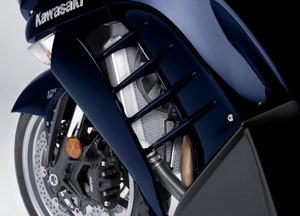 The changes to the bike can be separated into two categories: Those that center around rider comfort and improve the bike’s touring capabilities, and those aimed directly at improving safety.
The changes to the bike can be separated into two categories: Those that center around rider comfort and improve the bike’s touring capabilities, and those aimed directly at improving safety.Get comfy
Of the updates that enhance the rider environment, improving heat management was priority numero uno to consumers participating in focus groups. Yep, it’s no secret that the first iteration of the C-14 dumped heat on the rider, as we noticed in the 2008 intro.
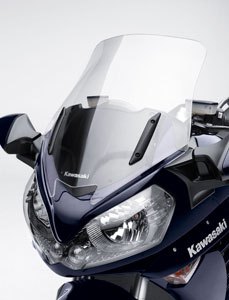 The new model has restyled, “heat dissipating” bodywork. The lower portion of the main fairing that sits out in front of the rider’s legs is now wider and has larger venting in order to better move hot air away from the rider while in motion. A new seal between the fairing and engine was also added to cut back on the heat dumped on the rider during idle.
The new model has restyled, “heat dissipating” bodywork. The lower portion of the main fairing that sits out in front of the rider’s legs is now wider and has larger venting in order to better move hot air away from the rider while in motion. A new seal between the fairing and engine was also added to cut back on the heat dumped on the rider during idle.Though ambient air along our ride route in the Palm Springs area and surrounding mountain communities was in the upper 80s to low 90s, I was still able to get a sense that less heat was making its way to me than it did on the previous Connie. Seems Kawi’s use of Computational Fluid Dynamics paid dividends in getting rid of the heat.
Next up is a new windscreen 70mm taller than the previous. It’s also wider at the top for increased wind protection. In an effort to reduce buffeting, new air passages were added under the screen and in the upper right and left portions of the dash area. Further aiding (if even a little) in wind protection and improving rearward views are mirrors that are now 40mm higher.
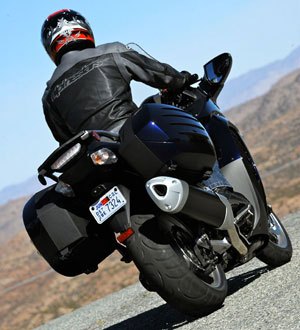 The changes seem subtle, but the experience was that the goal of better wind protection and less buffeting was met. Really, though, this is one of those subjective areas, as rider heights vary widely, so you’re likely to agree or disagree pending your inseam.
The changes seem subtle, but the experience was that the goal of better wind protection and less buffeting was met. Really, though, this is one of those subjective areas, as rider heights vary widely, so you’re likely to agree or disagree pending your inseam.More trick than a taller screen is how the rider is now able to better tailor its position. The same stepless pushbutton adjustment exists on the left switchgear, but four factory preset positions are now available. It’s important to note, however, that a rider cannot chose at any time any of the four, but rather only one of the four positions can be programmed as a default position.
"Of the updates that enhance the rider environment, improving heat management was priority numero uno to consumers..."
The windscreen will move from its fully retracted position (that it returns to every time the bike is off) to either: lowest, halfway, three-quarters or fully extended.
Depending on which of those the rider has chosen to enter as the default, it will display in the LCD portion of the instrument panel’s memory function. You can at anytime continue to move the screen via the stepless up/down button. Cool!
| Team Green Gets Greener |
| Whether bowing to trends, or just feeling guilty, Kawasaki has given the new Concours the eco-treatment. Part of the new LCD display is an ECO symbol in left of the screen that activates when the rider is operating the bike in an “efficient” manner. Typically, the eco symbol displays when the engine is just about anywhere below 6,000 rpm and the rider’s not ramming the throttle to the stops. If you’re an activist you can purposely put the Connie into green-friendly power. Via the new Mode button on the left switchgear a rider can select the ECO Mode Switch. In any gear and at any speed below 6,000 rpm and less than 30% throttle opening the bike’s ECU will switch to a leaner mapping, theoretically improving fuel economy and whatnot. Al Gore finds this all very convenient. |
A rather small storage compartment that was on the previous C-14’s fuel tank has now been replaced by a more usable compartment on the left portion of the inner fairing directly below the left grip.
This new space is not only bigger but is sealed shut via an electromagnet that locks when the ignition is off or the bike is moving above 25 mph. When the ignition is on, or the bike is (somehow!) moving under 2 mph, the compartment is unlocked. You’re good to get at least a pair of gloves in there, maybe a mobile phone, and possibly even more.
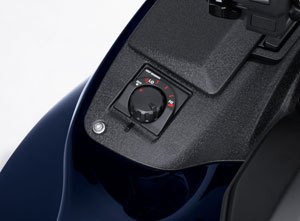 Where the old tank top storage existed is a new plastic “tankbag panel” with integrated hooks, and now allows use of either a magnetic or non-magnetic tankbag. A Kawasaki bag designed specifically for the Connie is en route soon according to Edmondson.
Where the old tank top storage existed is a new plastic “tankbag panel” with integrated hooks, and now allows use of either a magnetic or non-magnetic tankbag. A Kawasaki bag designed specifically for the Connie is en route soon according to Edmondson.Sitting just below the new storage is a new rheostat dial that will be a welcome feature to all those looking at the new Connie. It’s your new heated grip temp adjuster!
Rather than just a two-position switch like on BMWs, the Connie’s offers a wider range of adjustment. Again recounting the heat of the day, I accepted the burden of sampling the grips. Setting the dial to roughly halfway, I could feel them heat up through my mid-weight leather gloves, in what I estimated at less than one minute. Putting the dial to Hi was more than my paddies could take. Hot stuff, meng!
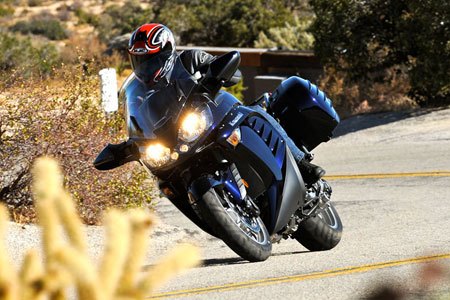 |
One of the electronic items that make life aboard the C-14 better, or at least more informed, is a new Mode button placed on the front side of the left switchgear, easily accessed by your index finger.
This new button performs all the same functions as the non-descript mode button on the dash, but now allows a rider to keep his or her hands on the grips rather than reaching forward (with just a tinge of resentment) to access the various bits of info on the LCD.
Also, Kawasaki has (finally!) graced the LCD with an ambient temp reading. It’ll be obvious to you, as it displays boldly, OUTSIDE, with the temp just below. For as accurate a reading as possible the temp sensor is located in the air intake duct, and updates after 12 mph.
Krazy for K-safety!
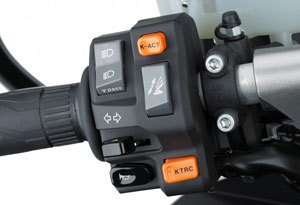 Although the numerous ride-enhancing features listed above came about mostly at the request of riders and not so much from Kawi engineers, Kawasaki did have every intention of giving the new Concours updated linked ABS (K-ACT) and traction control (KTRC).
Although the numerous ride-enhancing features listed above came about mostly at the request of riders and not so much from Kawi engineers, Kawasaki did have every intention of giving the new Concours updated linked ABS (K-ACT) and traction control (KTRC).The previous Connie was available with optional ABS. The 2010 model also has optional ABS, but now it's also a new second-generation version of the linked system found on the Voyager. The system on the Connie is 25% smaller, 30% lighter and operates with an upgraded ECU.
But what really sets the new linked-ABS apart is the rider-selectable level of linking. For starters, ABS cannot be disabled, but by pressing the orange K-ACT button (bike must be stopped to select modes) the rider can choose the “high-combined” effect in Mode 2 or the lesser-combined effect in Mode 1.
K-ACT mode selection impacts the amount of front brake application (only one of the two front calipers are involved regardless of Mode 1 or 2) when applying only the rear brake. The amount of linking applied to the rear when using the front brake remains constant.
One of the first acts of eval I wanted to perform was to see just how well the new ABS worked, as Kawi staff encouraged us to sample it.
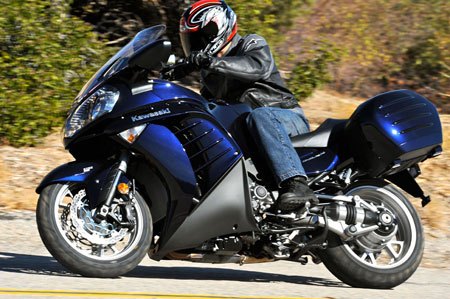 |
Purposely dismissing use of the front brake, I mashed on the rear brake in high-combined mode and was, well, shocked at just how much force was applied to the front by the system. It was almost like grabbing a handful.
Of course less effort at the rear brake pedal will result in less front application; regardless of mode selection the ABS’ brain makes “infinitely variable” adjustments. Using the lesser of the two settings, front brake application via K-ACT is nearly imperceptible, and in some instances preferable, at least for my taste.
When ABS did activate I was pleased with the minimal feedback (pumping) through the pedal and/or lever.
Beyond the typical “ramping up” in braking effort that K-ACT generates, as do most anti-lock systems, the most notable experience is just how forceful front application can be. Be sure to sample it in small doses at first until you get the feel. Good or bad, front brake involvement in this linked system is greater (when in High mode) than in any other linked ABS I’ve used.
A special double circle symbol displays in the lower right of the LCD to indicate K-ACT modes.
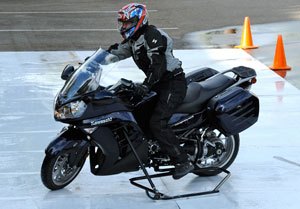 With the new Concours, Kawi created its first traction control system. Unlike the ABS, the rider can disable or enable KTRC, and can do so on the fly. The new TC system isn’t level selectable, like, say, Ducati’s DTC, and it isn’t intended to allow a rider to go faster on their Connie. It is largely a safety feature.
With the new Concours, Kawi created its first traction control system. Unlike the ABS, the rider can disable or enable KTRC, and can do so on the fly. The new TC system isn’t level selectable, like, say, Ducati’s DTC, and it isn’t intended to allow a rider to go faster on their Connie. It is largely a safety feature.Furthermore, by utilizing the existing ABS wheel speed sensors and main ECU, the new TC doesn’t add weight. By controlling airflow (via secondary butterfly valves in the throttle body), fuel delivery and ignition timing, three parameters as opposed to the two of competitors according to Kawasaki, the system limits engine output when it senses the rear wheel spinning faster than the front.
And for those wondering, yes, it is a wheelie nanny, but only when enabled. Phew!
Most impressive was how seamlessly and unobtrusively KTRC performed. When power is cut, it isn’t done abruptly, nor is reapplication of power. Rather than a stumbly on/off throttle experience, the bike simply feels like it has a fraction of its available power.
Kawi staff had a Connie fitted with outriggers to prevent tip over in a skip-pad area set-up in a parking lot for a controlled environment in which to sample KTRC and K-ACT. This scenario was an easy way to see the systems in action. However, I chose a more "real world" setting earlier in the day..
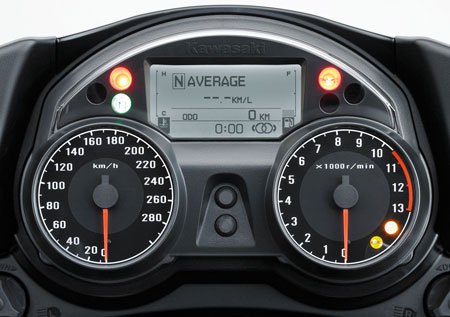 In the updated LCD and dash area we can see indicators for K-ACT and KTRC. The double circle in the lower right of the LCD is displaying high-combined mode of the linked ABS (K-ACT). When in low-combined the “parenthesis” around the circles disappears. The lower orange KTRC indicator in the tachometer is illuminated when KTRC is disabled. When enabled the light is off, and when KTRC is working it flashes. In the updated LCD and dash area we can see indicators for K-ACT and KTRC. The double circle in the lower right of the LCD is displaying high-combined mode of the linked ABS (K-ACT). When in low-combined the “parenthesis” around the circles disappears. The lower orange KTRC indicator in the tachometer is illuminated when KTRC is disabled. When enabled the light is off, and when KTRC is working it flashes. |
Searching out the loosest, gravely, sandy shoulders of the road I could find along our route, I did my best to spin up the rear whilst in first gear. No dice. The traction control system seemed highly sensitive and reacted quickly. More time in the saddle may reveal some drawbacks, but for now KTRC appears an excellent add-on.
Finally, the traction control system is only available on the ABS model.
New Connie wrap-up
The new electro wizardry and creature comforts are at the heart of the changes to the new Concours 14, with the engine and chassis remaining unchanged. But there are a few minor updates (and one not so minor!).
That big bazooka of an exhaust can is now 40mm shorter, and has a new front and rear end cap design; the amount of fork oil was increased, raising fork ride height by about 8mm, to allegedly improve quicker handling with better stability; and a second KIPASS FOB is included for hiding on the bike, but will only operate when next to the “immobilizer antenna.”
These are all handy items, but perhaps the best improvement is new Bridgestone BT021U tires. Our time on the first generation Connie in this year’s sport-touring shootout revealed a heavy steering Concours.
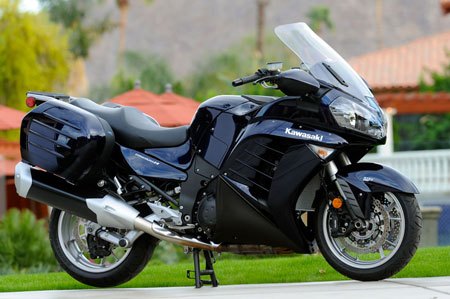 The new Connie: By the people, for the people. The new Connie: By the people, for the people. |
Though neither Bridgestone nor Kawi made any type of official admission of guilt, so-to-speak, Kawasaki discovered that the existing BT021 would quickly develop an usual shape, apparently not readily visible, in the center of the tread that seemed to contribute the Connie’s less-than-perfect handling traits.
Regardless of how this tire flaw was determined, the 2010 Concours comes with a “new” set of BT021U buns, with the front tire carrying “thicker rubber.”
Only time and more miles will tell if the new tire resolved sluggish steering response, but the new Connie's handling is crisper and is now much more neutral.
If you want the 2010 Concours 14 you can have it any color you want as long as it’s Candy Neptune Blue. The standard model is $14,599, while the ABS/KTRC model is $15,299.
So, if Kawasaki is willing to listen to one more piece of input, I suggest not importing any of the standard models. Considering how well the new traction control and linked ABS work, not to mention all the other updates, I can’t imagine anyone not spending the paltry $700 fee to step up to the People’s Concours 14.



 11:39 PM
11:39 PM
 Unknown
Unknown


 Posted in:
Posted in: 




0 comments:
Post a Comment